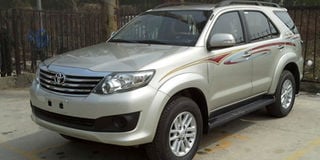With parking assist, my Fortuner is easy to park

Despite its seemingly big size, the fortuner is easy to park. PHOTO/RACHEL MABALA
What you need to know:
- Fuelling. According to Kenneth Kimuli, his 3000cc engine size car gives him between 10-15km using one litre of fuel on a highway. However, he says, when you accelerate more, it will consume more fuel.
From the front, the Toyota Fortuner can easily be mistaken for a Toyota Hilux. It is until you look at it from the sides that you see a difference. It is not a secret that the Fortuner was curved or built out of the Toyota Hilux body, with one of the differences between the two Japanese brands being the open and covered cabins respectively. Motorists share why they own this car.
Allan Mugume
When travelling upcountry, the Fortuner can comfortably accommodate my whole family of eight. It was manufactured as a seven-seater car but has capacity to carry up to 10 passengers of average size. This makes it a good family mid-size SUV.
Much as it is somewhat big, it is not as long. Therefore, it is easy to park even in small spaces.
Mine runs on a 2700cc engine size with an automatic transmission that can averagely give you 10 to 14 kilometres using one litre of fuel on the highway. If you have a challenge with reverse parking raised vehicles, the Fortuner eases it for you because it comes with park assist sensors with a rear view camera on the dashboard.
When the sensor senses are about to knock an object, it alerts you with an alarm.
On average, I spend approximately Shs300,000 on service and maintenance and this will cater for an engine oil change, spark plugs, air cleaners, brake pads and a few other major parts. When I carry out full service, it costs me close to Shs1m but this is done once or twice a year depending on where and how often you drive the car.
On average, I spend between Shs100,000 and Shs150,000 on fuel a week from my home in Naalya, Kampala to the city centre for work.
Nelson Tugume
The Toyota Fortuner comes with both automatic and manual transmissions. I chose the manual transmission one because it is more engaging when on the road. My job involves travelling and being in the field and the many storage pockets of the Fortuner on the dashboard, the interior roof above the driver and co-driver heads, seats and all the doors means I can comfortably keep a lot of documents in the car.
With this car, you can drive over road humps or potholes at relatively high speeds and you will not feel any discomfort. This is because of the fact that it has strong shock absorbers that can withstand and contain any impact on rough roads.
Because I use it for field work, I spend between Shs300,000 to Shs400,000 to have it serviced and I do this once in three months. Sometimes, I can drive it for four months when it is still in good condition but I make it a habit to have it inspected for anything that might need servicing.
I have noticed that when you visit the garage periodically, you avoid incurring high costs when the car breaks down. A Fortuner is one such car to treat this way because its spare parts are somewhat costly. The care you give it determines how long it serves you.
Kenneth Kimuli
I owned a Toyota Fortuner 2005 model for quite some time and it is one of the most raised mid-size sport utility vehicles you can ever drive. Besides the ground clearance that allows you drive in the roughest of upcountry roads, its interior is spacious. It has three seat rows and those at the extreme rear end can be folded to create more space for extra luggage or passengers.
Mine was a four wheel drive (4WD) and it was enjoyable driving it through any terrain. There is plenty of legroom for the driver, co-driver and passengers which makes it comfortable to travel in even for long distances. It is also a multi-purpose vehicle and can be used as your garden or farm car, one to drive to work as well as a luxury car.
My particular model ran on a 3000cc engine size, which is fairly manageable because it gives you between 10-15km using one litre of fuel on a highway. However, when you accelerate more, it will consume more fuel.
In traffic jam, it will give you slightly less mileage of between eight to 11km using one litre of fuel. The engine in places with traffic jam keeps running and burns more fuel yet the car covers a short distance because the speed is not constant.




